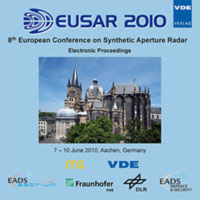Potentialities and limitations of hybrid space-airborne bistatic SAR
Conference: EUSAR 2010 - 8th European Conference on Synthetic Aperture Radar
06/07/2010 - 06/10/2010 at Aachen, Germany
Proceedings: EUSAR 2010
Pages: 4Language: englishTyp: PDF
Personal VDE Members are entitled to a 10% discount on this title
Authors:
Moccia, Antonio; Renga, Alfredo (University of Naples "Federico II", Italy)
Abstract:
Recently important experimentations were conducted on the use of space-airborne bistatic SAR. All the performed experiments relied on side-looking geometry both for the transmitter and the receiver, with platforms moving on parallel tracks, thus reducing geometric and radiometric distortions and focusing on synchronization and processing issues. However, present and future satellite illuminators shall allow more general observation geometries to be exploited for several additional applications with respect to remote sensing, such as navigation and surveillance, and the airborne receivers, depending on their working scenario, could be forced to gather data from arbitrary directions. On this basis a geometric analysis is carried out to define image resolutions and to individuate best/worst illumination conditions of the spaceborne transmitter.


